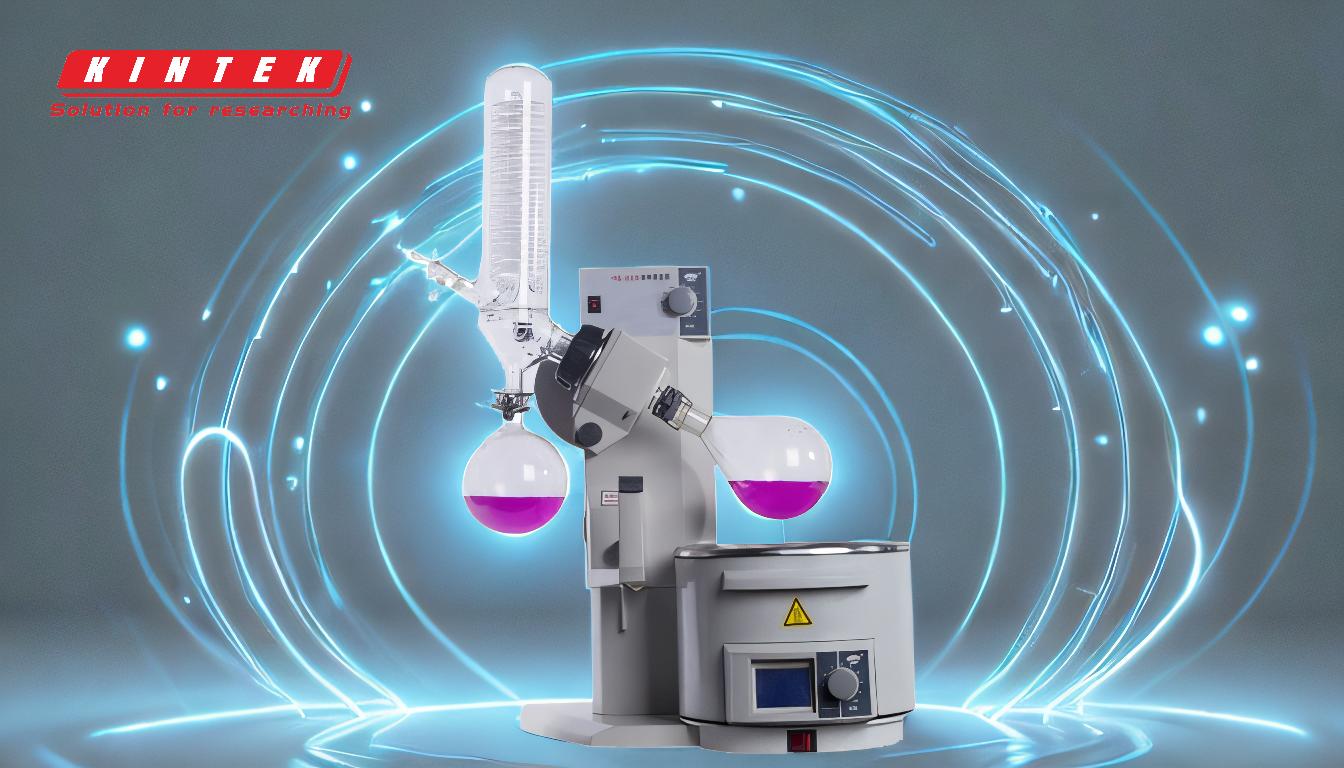A rotary evaporator, or rotovap, is a laboratory device used for the efficient and gentle removal of solvents from samples through evaporation. It operates by rotating a flask containing the solution under reduced pressure, which lowers the boiling point of the solvent, allowing it to evaporate at a lower temperature. The solvent vapor is then condensed and collected in a separate flask, leaving behind the concentrated compound. This process is widely used in chemistry and biochemistry labs for solvent removal, distillation, and concentration of samples. The key components of a rotary evaporator include a rotating flask, a water or oil bath, a vacuum pump, a condenser, and a receiving flask. The system ensures efficient evaporation while minimizing the risk of oxidation or degradation of the sample.
Key Points Explained:

-
Principle of Operation:
- A rotary evaporator works by reducing the pressure inside the system using a vacuum pump, which lowers the boiling point of the solvent.
- The rotating flask increases the surface area of the liquid, promoting faster evaporation.
- The solvent vapor is condensed back into liquid form in the condenser and collected in a receiving flask.
-
Key Components:
- Rotating Flask: Holds the solution and rotates to increase the surface area for evaporation.
- Water or Oil Bath: Provides controlled heating to the flask, ensuring uniform temperature distribution.
- Vacuum Pump: Reduces the pressure inside the system, enabling evaporation at lower temperatures.
- Condenser: Cools the solvent vapor, converting it back into liquid form.
- Receiving Flask: Collects the condensed solvent.
-
Steps to Operate a Rotary Evaporator:
- Preparation: Place the solution in the rotating flask and secure it with a bump trap to prevent splashing.
- Rotation: Start rotating the flask at a suitable speed to increase the evaporation surface area.
- Vacuum Application: Gradually apply vacuum to reduce pressure and initiate evaporation.
- Heating: Turn on the water or oil bath to provide controlled heat to the flask.
- Condensation and Collection: The solvent vapor condenses in the condenser and is collected in the receiving flask.
- Completion: Once all the solvent has evaporated, release the vacuum and stop the rotation.
-
Advantages of Using a Rotary Evaporator:
- Efficiency: The rotating flask and reduced pressure allow for rapid and efficient solvent removal.
- Gentle Process: Lower boiling points reduce the risk of sample degradation or oxidation.
- Versatility: Suitable for a wide range of solvents and sample types.
- Controlled Conditions: Precise control over temperature and pressure ensures reproducible results.
-
Applications:
- Solvent Removal: Commonly used to remove solvents from chemical mixtures.
- Distillation: Separates components based on their boiling points.
- Sample Concentration: Concentrates samples by removing excess solvent.
- Chemical Synthesis: Used in the purification and isolation of compounds.
-
Safety Considerations:
- Vacuum Handling: Ensure proper sealing to prevent leaks and maintain vacuum integrity.
- Temperature Control: Avoid overheating, which could damage the sample or equipment.
- Bump Traps: Use bump traps to prevent splashing or contamination during evaporation.
- Proper Venting: Release vacuum slowly to avoid sudden pressure changes that could damage the system.
-
Maintenance and Care:
- Regular Cleaning: Clean the rotating flask, condenser, and receiving flask after each use to prevent contamination.
- Inspection: Regularly inspect seals, gaskets, and connections for wear and tear.
- Lubrication: Ensure moving parts, such as the rotating mechanism, are properly lubricated.
- Calibration: Periodically calibrate temperature and vacuum controls for accurate operation.
By following these steps and understanding the key components and principles, a rotary evaporator can be effectively used for solvent removal and sample concentration in a laboratory setting.
Summary Table:
| Aspect | Details |
|---|---|
| Principle | Reduces pressure to lower boiling points, enabling gentle solvent removal. |
| Key Components | Rotating flask, water/oil bath, vacuum pump, condenser, receiving flask. |
| Steps to Operate | Preparation, rotation, vacuum application, heating, condensation, completion. |
| Advantages | Efficient, gentle, versatile, and controlled conditions. |
| Applications | Solvent removal, distillation, sample concentration, chemical synthesis. |
| Safety Considerations | Proper vacuum handling, temperature control, bump traps, and venting. |
| Maintenance | Regular cleaning, inspection, lubrication, and calibration. |
Optimize your lab processes with a rotary evaporator—contact us today to learn more!













